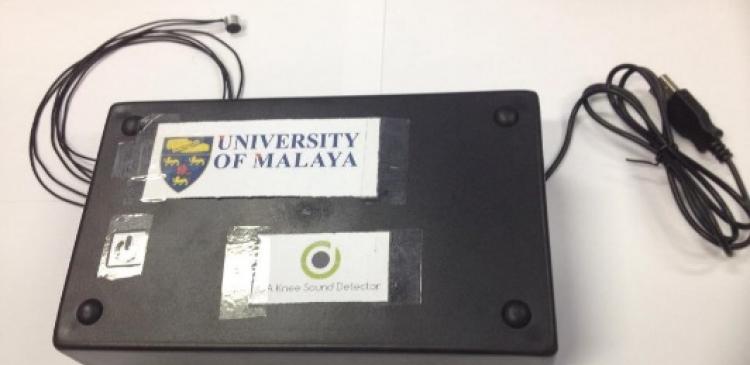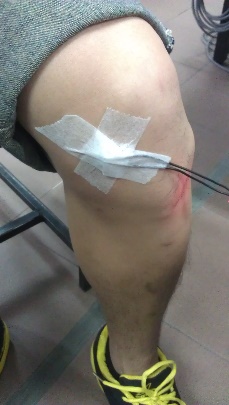Jerry Choon Cheah Wee with his awards at i-ENVEX 2015
Osteoarthritis (OA) is a degenerative joint disease, which is commonly occurred in knee joint. OA has become the major cause of disability in a many countries. Recent diagnosis methods for example X-Ray, Magnetic Resonance Imaging (MRI), Joint Fluid Analysis, and Arthroscopy have several complications such as presence of radiation, use of special room for isolation of radiation and magnetic waves, and it is invasive.
To have a non-invasive, radiation-free, early stage detection, and relatively inexpensive approach, a novel Knee Sound Detector has been developed based on sound recording on the medical compartment of subject’s knee. Firstly, we have a microphone attached to the subject’s knee for sound detection followed by microcontroller to help us to carry out all the processing procedure, and finally a graphical user interface (GUI) is need to help us to carried out assessment on the sound detected, based on amplitude and frequency of the sound samples.
For the amplitude approach, the higher the amplitude, the louder the knee sound will be detected. This is to determine the seriousness of the knee joint condition. Switching to frequency approach, it helps us to differentiate the type of sound detected from the knee joint. Usually, OA refers to the end-stage, which is already incurable. To carry out early detection, it is essential determine the pre-stage of OA, and there are patellofemoral disorder, and also meniscus tear. Each of this stage creates a sound with different frequency range. Based on the frequency approach, the stage or types of joint degeneration the patient or subject can be determined or predicted.
This Knee Sound Detector has a big potential for commercialization. So far in the market (even worldwide), there is no diagnostic equipment available for this OA disease based on knee sound. Besides, it is possible to commercialize it at low cost to accommodate different population groups. Just focusing on local market, Malaysia alone with a total population number of 30 million about 10% of people falls in the category of adult or elderly over 60 years old which mean that 3 to 4 millions of people will be the potential users of this device. With this number, this already proves that there is a demand for this technology.
This invention has won Gold and Best of The Best Award at International Engineering Invention & Innovation Exhibition (i-ENVEX) 2015 at Universiti Malaysia Perlis (UNiMap), Malaysia.
Contact:
Jerry Choon Cheah Wee
Dr. Lai Khin Wee
Dept. of Biomedical Engineering
Faculty of Engineering
University of Malaya
Tel : +6012-3185118
Fax : +603-79674579
Email : [email protected]
Patent Filed
PI 2015700928





